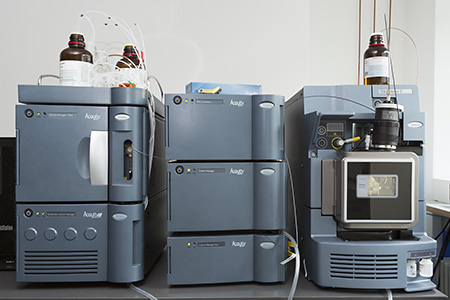Former Instruments
Compilation of previous instrumentation
Waters UPLC-MS
The Institute of Organic Chemistry acquired an UPLC-MS system comprising a UPCL with autosampler and photodiode detector and a single quadrupole mass analyzer with ESI and APCI combination ion source. This instrument, a Waters Acquity+SQD2 combination, was installed in Jan 2013 and since April 2013 the system was run in open access mode for researchers of OCI. A pure APCI source was added as it delivered by far better results in most cases of its typical use. Dimishing user request during the later years and finally a fatal failure in late fall 2023 led to the end of operation of this system. It was finally disassembled and removed from the lab towards end of 2024.

Finnigan LCQ Quadrupole Ion Trap
The Finnigan LCQ instrument (companny now Thermo Fisher Scientific) was installed in June 2010. It had been acquired as a second hand instrument from MasCom. The acquisition could be founded from tuition, because the LCQ will greatly improve our laboratory's up-time, which is particularly important during the preparation period of Bachelor theses, typically in May and June of a year.
The LCQ is a quadrupole ion trap (QIT) instrument and is operated in ESI mode. The instrument offers unit resolution and so-called zoom scans that allow to achieve better resolving power over small m/z ranges, e.g., to resolve isotopic patterns of doubly or triply charged ions. As a tandem-in-time device, the ion trap can be run in MSn mode.
The Finnigan LCQ was operated until end of 2021 and - following a break down of the computer system - eventually removed from the lab in accordance with the general development plan of our MS facility.

JEOL JMS-700 Magnetic Sector Instrument
The JEOL JMS-700 instrument (also known as MStation) was installed in April 1996. It is equipped with EI, CI, FAB and FD ionization, GC coupling and collision cells in the first and second field free regions.
Its mass range is larger than m/z 2500 at full acceleration voltage of 10 kV. Resolution can reach up to R = 60000 in EI mode. We do much FAB and HR-FAB with this instrument, closely followed by EI, CI and FD applications.
A liquid injection field desorption/ionization (LIFDI) prototype probe has been installed on our JEOL JMS-700 by Linden CMS in Jan. 2006. LIFDI enables us to obtain FD mass spectra of compounds sensitive to air and moisture.
This instrument was run until summer 2019 and is being removed in summer 2020 from our lab. Without the covers, technical details and the geometry become more obvious.



Close-up to the ion source housing. Beginning clockwise on the lower left side you can see the reservoir inlet for volatile liquids, the GC coupled to the ion source housing, the Xe FAB gun on its top, slit height adjustment to its right. Connected to the vacuum lock on the right side but not inserted into the ion source, the water-cooled direct probe for sample introduction in EI, CI, and FI mode can be seen. The background is dominated by the magnetic sector.
Bruker Biflex time-of-flight instrument
The Bruker Biflex time-of-flight instrument was installed in August 1995. It is owned by Prof. Dr. W. Krätschmer. Therefore, fullerene research was one of its main tasks during the first years. In between a wide variety of samples such as peptides, oligonucleotides, oligosaccharides, porphyrins, calixarenes, some synthetic polymers and more have been analyzed by use of this TOF-MS. In Feb. 1999, it has been upgraded substantially by adding pulsed-ion extraction (PIE), sample observation optics and an MO drive for long term data storage.
The ion source of the Biflex has been replaced in Nov. 2001. Instead of the old one having a 10-target probe, the Scout26 ion source has 26 spots for sample preparation and what is more important, can move to any position on the target surface. Thus, it reduces the amount of sample needed for preparation. It was removed from the lab in May 2008.

Finnigan TSQ-700 instrument
The Finnigan TSQ-700 instrument (Company now Thermo Fisher Scientific) was installed at OCI in August 2000. The second hand device had its first installation in 1992 and has been fully refurbished by MasCom before joining our lab. It is equipped with an EI/CI combination ion source and with a Finnigan ESI 1 ion source from 1997. The EI/CI capability is needed to replace the VG-ZAB-2F in near future. The ESI ion source really adds new capabilities to our facility. The standard mass range of the quadrupoles is up to m/z 2000 and may be extended to m/z 4000 if resolution is not an issue. As usual for quadrupole mass spectrometers, resolution is 1 u at any m/z, so-called unit mass resolution.

The glass cover on the whole vacuum manifold allows a nice insight into the TSQ.
On the bottom of the picture you can see the octapole ion guide of the ESI source functioning as a bridge between the skimmer and the first quadrupole, Q1.
Q1 reaches through the baffle into the second part of the vacuum manifold from where ions are passed through the RF-only quadrupole which can be used as collision cell for CID experiments. Despite of being called the second quadrupole of the TSQ, Q2 consists of an octapole assembly in order to improve ion transmission under CID conditions.
Next, the third quadrupole, Q3, is operated as RF-only quadrupole allowing all ions to pass in MS mode, whereas it is operated as a mass analyzer in MS/MS mode.

VG ZAB-2F
The VG ZAB-2F magnetic sector instrument (BE) was equipped with an EI source and GC-MS coupling. The instrument had been installed in 1979 by Dr. D. Kraus. It has been operated for MS@OCIHD until it has been uninstalled on April 24th, 2002 by the Grotemeyer group. It has been reinstalled at the University of Kiel for educantional purposes (Apr. 2002).





